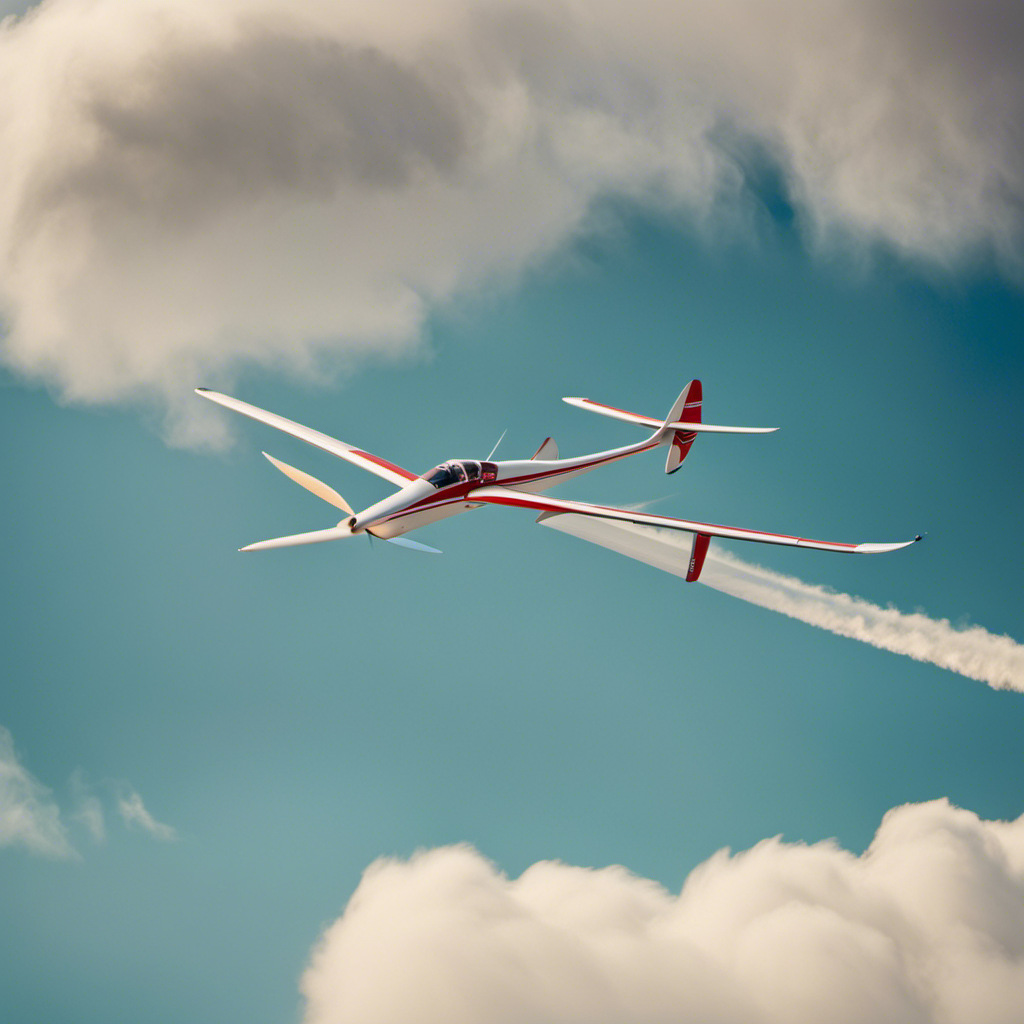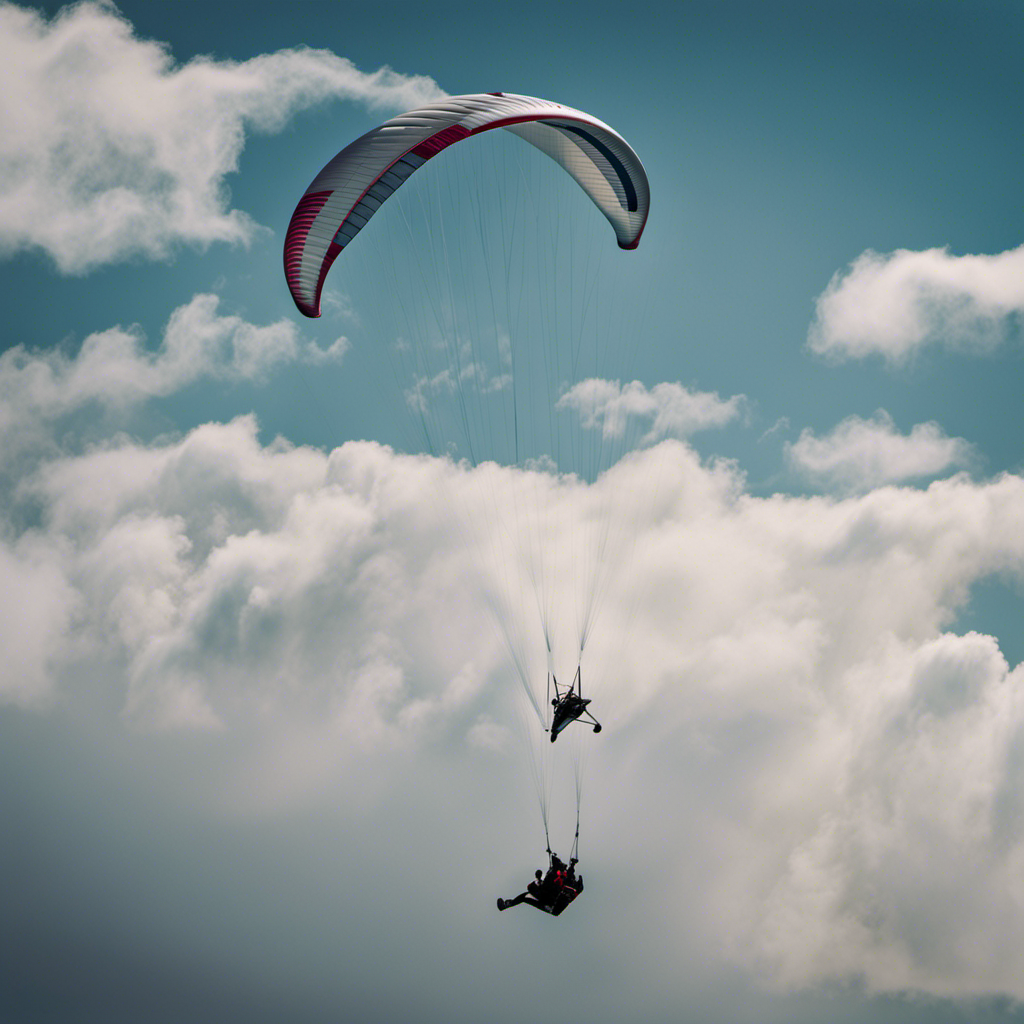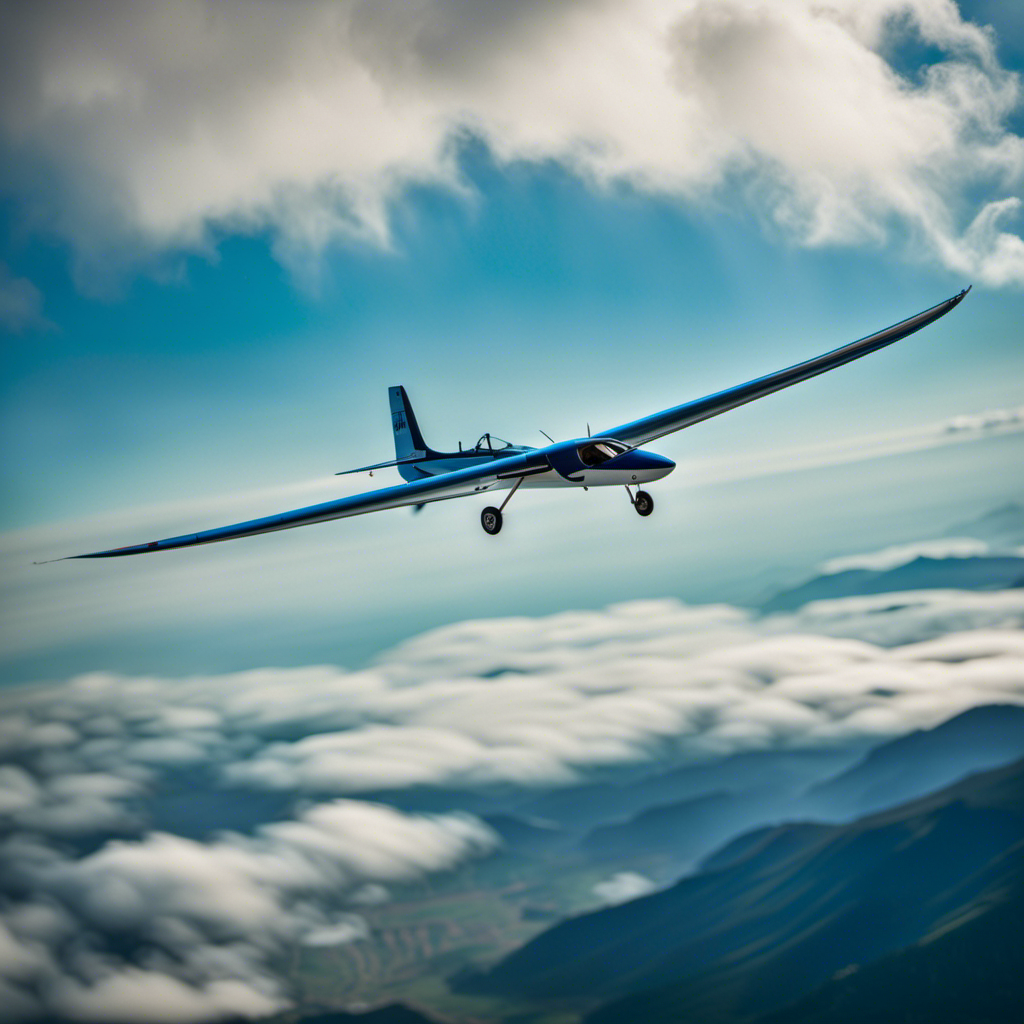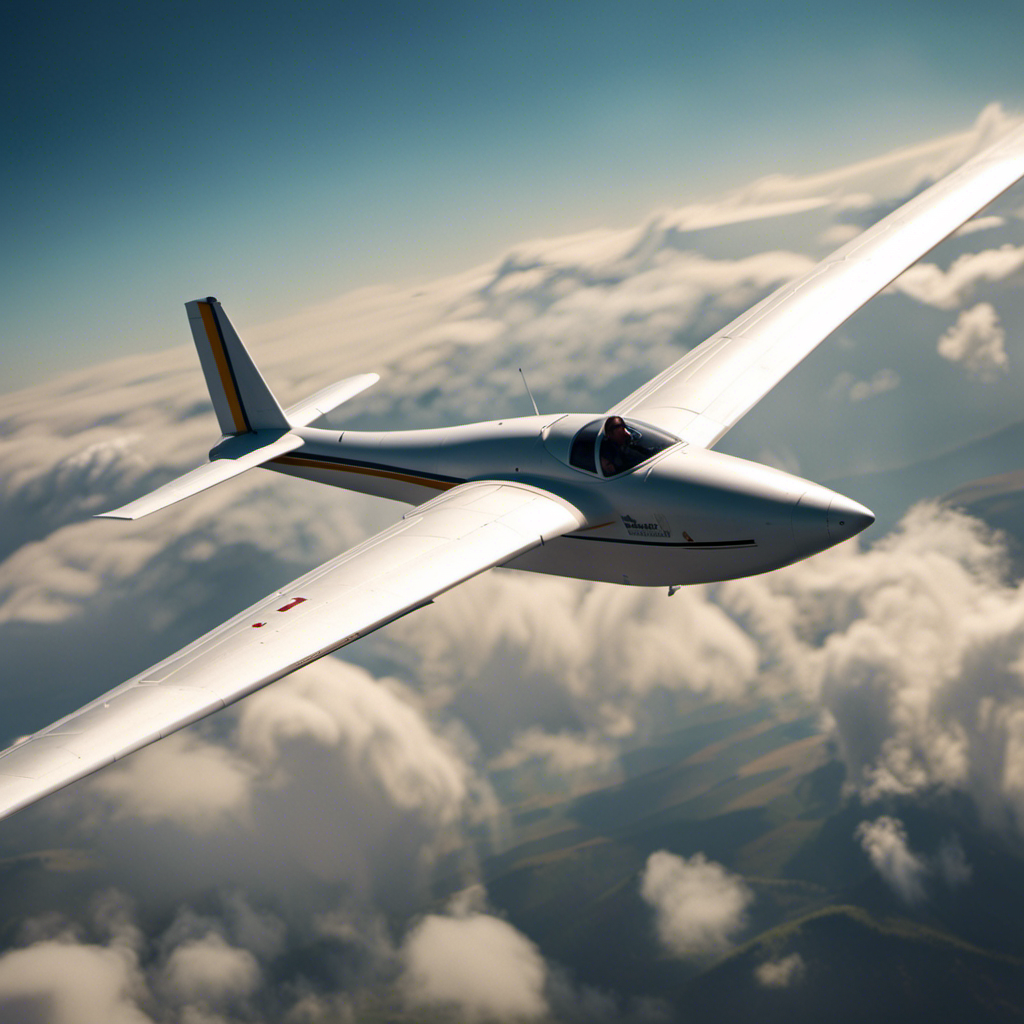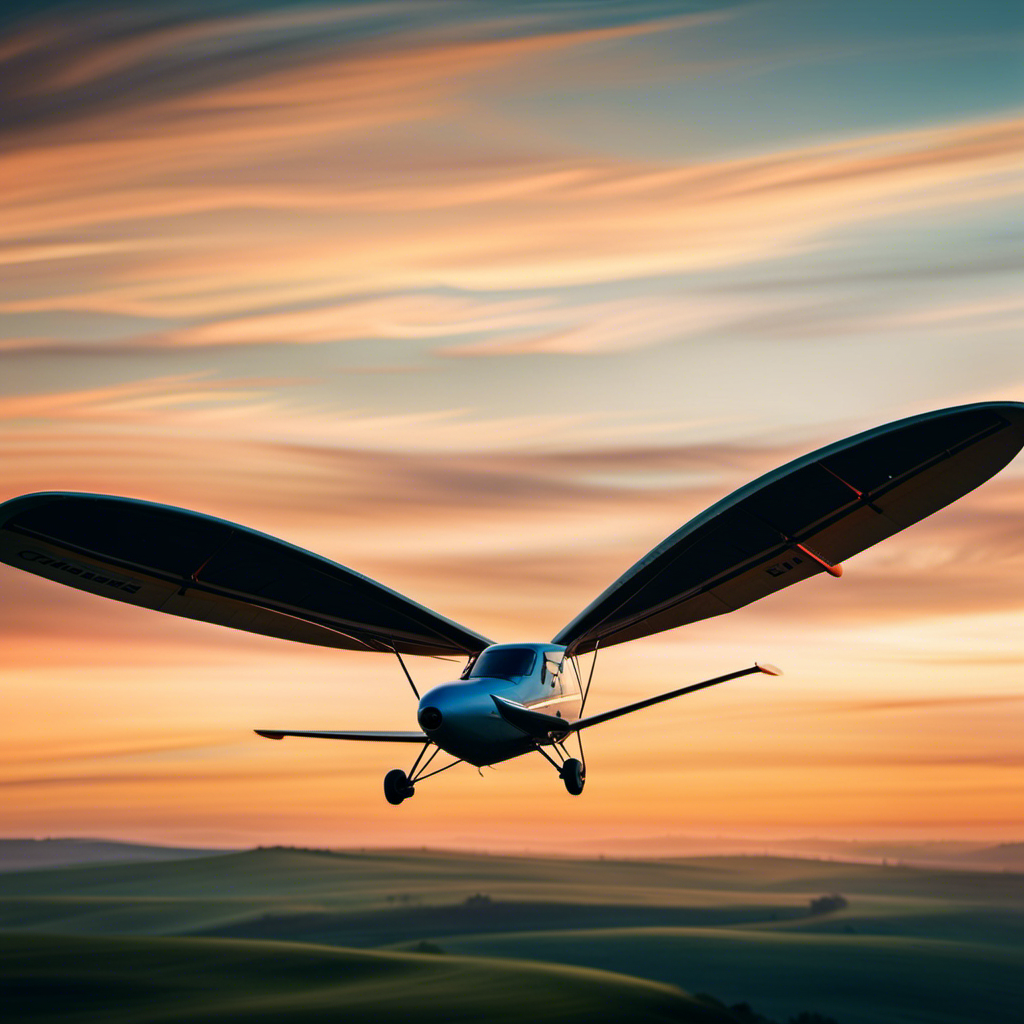Do you have a strong desire to discover the skies? Get ready to take flight as we set off on an adventure into the world of gliding. Whether you are a seasoned enthusiast or a beginner with a curiosity, this thorough guide will give you the necessary details to grasp the different glider options out there.
From fixed-wing sailplanes to motorized gliders, hang gliders to paragliders, we’ll explore the intricacies of each aircraft.
So buckle up and prepare for an exhilarating journey into the fascinating world of gliding.
Key Takeaways
- Fixed-wing gliders are a popular choice for longer flight duration due to their sleek and aerodynamic design.
- Motorized gliders combine the benefits of gliding and powered flight, allowing for shorter runway requirements and extended flight duration.
- Hang gliders are lightweight aircraft launched by running downhill to catch the air and lift off, controlled by shifting weight and adjusting the control bar.
- Paragliders are non-motorized aircraft relying on natural elements for lift, launched by running down a slope or taking off from a hillside, controlled by shifting weight and manipulating brake lines.
Fixed-wing Gliders
Fixed-wing gliders are a popular choice among enthusiasts because they offer a longer flight duration. With their sleek and aerodynamic design, these gliders harness the power of wind currents to stay airborne for extended periods.
The fixed-wing configuration ensures stability and control during flight, allowing pilots to make precise maneuvers. These gliders are equipped with a rigid wing structure, which provides the necessary lift to keep them gliding through the air. The wings are typically made of lightweight materials such as carbon fiber or fiberglass, ensuring optimal performance and efficiency.
Fixed-wing gliders are perfect for those who crave a more extended and thrilling gliding experience.
Now, let’s delve into the fascinating world of sailplanes, which take gliding to new heights.
Sailplanes
To fully experience the thrill of soaring through the sky, you’ll need to explore the world of sailplanes. These non-motorized aircraft offer a unique and exhilarating way to glide effortlessly through the air. Here are three key features of sailplanes that make them a popular choice among aviation enthusiasts:
-
Efficient design: Sailplanes are built with streamlined and aerodynamic shapes, allowing them to maximize lift and minimize drag. This design enables them to stay aloft for extended periods without the need for an engine.
-
Long wingspan: Sailplanes typically have long wingspans, which helps them generate lift and maintain stability in the air. The longer wingspan also allows for a larger surface area, increasing the glider’s ability to stay airborne.
-
Variable ballast system: Sailplanes often come equipped with a variable ballast system, which allows pilots to adjust the weight distribution of the aircraft. This feature is particularly useful for optimizing flight performance and handling in different weather conditions.
With sailplanes, you can truly experience the freedom of soaring through the sky, relying solely on the forces of nature.
Now, let’s delve into the world of motorized gliders and discover another exciting facet of gliding.
Motorized Gliders
Motorized gliders, also known as powered gliders, are a unique type of aircraft that combine the benefits of both gliding and powered flight. These aircraft are equipped with engines that allow them to take off independently and maintain powered flight, while also having the ability to glide and soar without the use of the engine.
The advantages of motorized gliders include the ability to take off and land on shorter runways, increased flexibility in flight planning, and the option to extend flight duration by using the engine.
However, there are also some disadvantages, such as the added weight and complexity of the engine system, higher maintenance requirements, and increased fuel consumption.
Popular models and manufacturers of motorized gliders include the Stemme S10-VT, the Pipistrel Taurus, and the DG-808C produced by DG Flugzeugbau.
Introduction to motorized gliders
A popular option for aviation enthusiasts looking for a versatile glider is the motorized glider. With its unique combination of motorized propulsion and gliding capabilities, this type of aircraft offers an exciting experience like no other.
Here are three key features that make motorized gliders a top choice for many pilots:
-
Engine power: Unlike traditional gliders that rely solely on thermal or ridge lift, motorized gliders have an engine that can provide an extra boost when needed. This allows for greater flexibility in terms of takeoff and landing locations, as well as the ability to extend flight time.
-
Self-launch capability: Motorized gliders can self-launch, meaning they don’t require a tow or winch to get airborne. This independence gives pilots the freedom to explore new locations and fly on their own terms.
-
Dual functionality: Motorized gliders can operate as both gliders and powered aircraft. This means they can be flown with the engine off, utilizing the art of gliding, or with the engine on for powered flight. This versatility makes motorized gliders suitable for a wide range of flying conditions.
Motorized gliders offer a unique blend of gliding and powered flight, providing pilots with an array of advantages and some challenges to consider.
Advantages and disadvantages of motorized gliders
If you’re considering flying a motorized glider, it’s important to weigh the advantages and disadvantages of this unique aircraft. Motorized gliders combine the benefits of a traditional glider with the added power of an engine. Here is a table that highlights the advantages and disadvantages of motorized gliders:
| Advantages | Disadvantages |
|---|---|
| Ability to take off and land on shorter runways | Higher initial cost compared to non-motorized gliders |
| Increased safety with the ability to extend flight time if needed | Additional weight from the engine reduces gliding performance |
| Flexibility to fly in a wider range of weather conditions | Increased maintenance and fuel costs |
| Improved ability to fly against headwinds or in areas with weak thermals | Noise and vibration from the engine can affect the gliding experience |
| Easier to transition from powered aircraft to gliders | Reduced soaring skills development due to reliance on the engine |
Considering the advantages and disadvantages, motorized gliders offer a unique flying experience with increased flexibility and safety. Now, let’s explore popular models and manufacturers in the next section.
Popular models and manufacturers
When it comes to popular models and manufacturers, you’ll find a wide range of options in the world of motorized gliders.
One notable model is the Pipistrel Sinus, manufactured by Pipistrel in Slovenia. This glider is equipped with a Rotax engine, which provides excellent performance and fuel efficiency.
Another popular choice is the Schempp-Hirth Duo Discus X, manufactured by Schempp-Hirth in Germany. This glider features a retractable engine and offers both solo and tandem flying capabilities.
Additionally, the Stemme S12 is renowned for its sleek design and long-range capabilities. Manufactured in Germany, this glider is equipped with a turbo engine, allowing for extended flights.
Now, let’s transition into the subsequent section about hang gliders, which offer a different flying experience.
Hang Gliders
Hang gliders are lightweight aircraft that are designed for soaring through the air. They consist of a rigid wing and a harness for the pilot to hang from.
Hang gliders are launched by running down a slope or being towed by a vehicle, and they are controlled by shifting the weight of the pilot to control the direction and speed of flight.
Safety considerations for hang gliding include proper equipment maintenance, weather conditions, and emergency procedures. Training is essential for learning how to safely launch, control, and land a hang glider, and it involves both classroom instruction and hands-on practice under the guidance of a trained instructor.
Overview of hang gliders
Hang gliders are a popular choice for thrill-seekers and adventure enthusiasts. These lightweight aircraft are designed to soar through the air, giving you a unique and exhilarating experience.
Hang gliders consist of a rigid wing made of aluminum or composite materials, and a harness for the pilot to sit in. The wing is shaped like an airfoil, allowing it to generate lift as it moves through the air.
To launch a hang glider, you need a suitable location with a slope or a hill. You run downhill, allowing the wing to catch the air and lift you off the ground.
Once in the air, you control the hang glider by shifting your weight and adjusting the control bar. This allows you to turn, climb, and descend, giving you complete control over your flight.
How hang gliders are launched and controlled
Now that you have a good understanding of hang gliders, let’s delve into the fascinating world of how these remarkable aircraft are launched and controlled.
Hang gliders are typically launched from a hill or towed behind a boat or vehicle. The launch process involves running down the slope or being towed until the glider achieves the necessary lift to become airborne.
Once in the air, hang gliders are controlled by the pilot’s weight shift and use of a control bar. By shifting their body weight, the pilot can steer the glider left or right, while pushing or pulling the control bar allows them to control the pitch. It’s a delicate dance of balance and coordination between the pilot and the glider.
Now, let’s explore the safety considerations and training requirements for aspiring hang glider pilots.
Safety considerations and training requirements
Before embarking on the exhilarating journey of becoming a hang glider pilot, it is essential to understand the safety considerations and training requirements involved. Here are the key things you need to know:
-
Safety gear: Invest in a high-quality helmet, harness, and sturdy footwear to protect yourself during flights.
-
Training courses: Enroll in a certified hang gliding school to receive proper instruction on launching, controlling, and landing techniques.
-
Physical fitness: Hang gliding requires a good level of physical fitness, as you will need strength and endurance to handle the glider and withstand the physical demands of flight.
-
Weather conditions: Familiarize yourself with weather patterns and learn how to assess wind speed, direction, and other factors that can affect the safety of your flight.
Understanding these safety considerations and completing the necessary training will lay a solid foundation for your journey as a hang glider pilot.
Now, let’s explore the world of paragliders and their unique characteristics.
Paragliders
When it comes to paragliders, it’s important to understand their basic structure and functionality. These aircraft are designed with a flexible, wing-like structure and are typically made of lightweight materials like nylon or polyester.
Paragliders are launched by running downhill or being towed by a vehicle, and once in the air, they are controlled by manipulating the brake lines to control speed and direction.
It’s worth noting that while paragliders and hang gliders may appear similar, they have distinct differences in terms of design, control, and flying characteristics.
Introduction to paragliders
If you’re looking to explore the world of paragliders, you’ll find that they offer a unique and thrilling flying experience. Paragliders are lightweight, non-motorized aircraft that rely on the natural elements for lift and maneuvering.
They consist of a fabric wing, which is shaped like an airfoil, and a harness that the pilot wears. The wing is made up of cells that are filled with air, creating an inflatable structure that allows the paraglider to stay aloft.
To launch a paraglider, the pilot typically runs down a slope or takes off from a hillside, allowing the wing to catch the wind and inflate. Once in the air, the pilot can control the paraglider by shifting their weight and manipulating the brake lines attached to the wing. This allows them to turn, climb, and descend, giving them complete control over their flight path.
Now, let’s delve into how paragliders are launched and controlled.
How paragliders are launched and controlled
Now that you have an understanding of what a paraglider is, let’s dive into how these incredible aircraft are launched and controlled.
Paragliders are known for their simplicity, both in terms of equipment and operation. Here’s a breakdown of the launch and control process:
-
Ground Handling: Before takeoff, you’ll practice ground handling to get a feel for the glider’s responsiveness. This involves holding the risers and manipulating the wing to control its position and movement.
-
Inflation: To launch the paraglider, you’ll need to generate air pressure in the canopy by running forward. As the wing fills with air, it rises above you, ready for flight.
-
Brake Control: Once in the air, you’ll use the brake toggles to control the speed, direction, and pitch of the paraglider. Pulling on the brakes slows the wing down, while releasing them allows it to gain speed.
Transitioning into the next section, it’s important to note the differences between paragliders and hang gliders.
Differences between paragliders and hang gliders
Transitioning to the differences between paragliders and hang gliders, it’s important to understand their unique characteristics.
Paragliders are flexible, inflatable winged aircraft that are launched by foot. They are designed to allow for easy transportation and setup.
Hang gliders, on the other hand, have a rigid frame with a triangular-shaped wing. They are typically launched by running off a hill or being towed by a vehicle. Hang gliders offer a more dynamic flying experience with greater speed and maneuverability. They require more space for storage and transportation due to their larger size.
Now, let’s move on to the next section and explore the fascinating world of ultralight gliders, which offer a whole new level of excitement and adventure.
Ultralight Gliders
Ultralight gliders, also known as microlights, offer a thrilling and economical way to soar through the skies. These lightweight aircraft are designed to be easily maneuverable and affordable, making them accessible to a wide range of enthusiasts. With their compact size and efficient design, ultralight gliders can achieve impressive speeds and altitudes while using minimal power.
To give you a better understanding of the capabilities and specifications of ultralight gliders, here is a table showcasing some key features:
| Feature | Description |
|---|---|
| Wingspan | Typically between 9 and 15 meters |
| Maximum Weight | Usually below 450 kilograms |
| Engine | Powered by a small, lightweight engine |
| Speed Range | Varies from 65 to 150 kilometers per hour |
Now that you have a grasp of ultralight gliders, let’s move on to the next section about vintage gliders, which offer a different experience and charm.
Vintage Gliders
If you’re looking for a unique and nostalgic flying experience, vintage gliders can transport you back in time with their classic design and graceful flight characteristics. These gliders, also known as antique gliders, were built during the early years of aviation and offer a glimpse into the past.
With their wooden frames, fabric-covered wings, and open cockpits, vintage gliders exude a sense of adventure and simplicity. The flight characteristics of these gliders are smooth and gentle, allowing pilots to soar through the sky with ease. Vintage gliders are perfect for those who appreciate the elegance and charm of a bygone era in aviation.
Now, let’s delve into the thrilling world of aerobatic gliders, where precision and adrenaline meet in the sky.
Aerobatic Gliders
Aerobatic gliders offer a thrilling flying experience, combining precision and adrenaline in the sky. These specialized gliders are designed to perform a wide range of aerobatic maneuvers with ease and finesse. With their sleek and agile design, aerobatic gliders can execute loops, rolls, spins, and other advanced maneuvers that defy gravity.
To give you a better understanding, here is a table showcasing some popular aerobatic gliders:
| Model | Max Glide Ratio | Max Speed (km/h) | Max G-Force |
|---|---|---|---|
| ASW-19 | 45:1 | 280 | +7/-5 |
| Sbach 342 | N/A | 400 | +10/-10 |
| Extra 330SC | N/A | 400 | +10/-10 |
| Swift S-1 | 44:1 | 270 | +7/-5 |
| Xtreme Decathlon | N/A | 280 | +6/-5 |
Aerobatic gliders are meticulously engineered to withstand the high forces and stresses encountered during these maneuvers. They often feature reinforced structures, enhanced control surfaces, and powerful engines for optimal performance.
Now, let’s transition to the next section, where we will delve into the world of experimental gliders.
Experimental Gliders
In this discussion, you’ll explore the fascinating world of experimental gliders. You’ll gain an overview of these unique aircraft that push the boundaries of aviation.
Discover how experimental gliders are meticulously developed and rigorously tested, ensuring their safety and performance.
Overview of experimental gliders
The overview of experimental gliders shows how these unique aircraft push the boundaries of aviation. These gliders are designed and built specifically for research and development purposes, allowing engineers and scientists to explore new concepts and technologies in flight. Below is a table that provides a visual representation of the different types of experimental gliders and their key features:
| Experimental Glider Type | Purpose | Key Features |
|---|---|---|
| High-altitude gliders | Study upper atmosphere | Pressurized cabins, specialized instruments |
| Electric-powered gliders | Test electric propulsion systems | Electric motors, battery packs |
| Aerobatic gliders | Explore extreme maneuverability | Reinforced airframes, high-performance wing designs |
These gliders are developed and tested through rigorous processes that involve computer simulations, wind tunnel testing, and actual flight trials. By continually pushing the boundaries of what is possible in aviation, experimental gliders pave the way for advancements in aircraft design and technology. In the next section, we will delve into the fascinating world of how these gliders are developed and tested, providing insights into the intricate processes involved.
How experimental gliders are developed and tested
Developers and engineers utilize computer simulations, wind tunnel testing, and actual flight trials to create and evaluate experimental gliders. These methods allow for a thorough understanding of the glider’s performance and capabilities. Here’s a step-by-step breakdown of the development and testing process:
-
Computer Simulations: Using advanced software, engineers can simulate various flight conditions and analyze the glider’s aerodynamic behavior. This helps in optimizing the design and identifying any potential issues.
-
Wind Tunnel Testing: Physical models of the glider are tested in a wind tunnel to measure its lift, drag, and stability. This provides valuable data for further design refinements.
-
Actual Flight Trials: Once the glider design is finalized, it undergoes real-world flight trials. Skilled test pilots evaluate its handling characteristics, stability, and performance in different flight scenarios.
-
Data Analysis: The data collected from simulations, wind tunnel tests, and flight trials is meticulously analyzed to identify areas for improvement and validate the glider’s performance.
Advancements and innovations in experimental gliders
Now that you understand how experimental gliders are developed and tested, let’s delve into the exciting advancements and innovations in this field.
Over the years, glider technology has evolved significantly, pushing the boundaries of what is possible in terms of design, materials, and performance. One notable advancement is the use of composite materials, such as carbon fiber, which offer excellent strength-to-weight ratios and improved aerodynamic efficiency. These materials have revolutionized glider construction, allowing for lighter, stronger, and more maneuverable aircraft.
Additionally, advancements in aerodynamics, including wing shape optimization and laminar flow control systems, have greatly improved glider performance, enabling pilots to achieve longer flights and higher speeds.
As we explore the future of gliders, these advancements will undoubtedly continue to shape the next generation of innovative and high-performance aircraft.
Future of Gliders
You might be wondering what the future holds for gliders, but rest assured, advancements in technology and design are paving the way for even more efficient and exciting flying experiences. Here are three exciting developments that are shaping the future of gliders:
-
Improved materials: Advanced composite materials such as carbon fiber are being used to create gliders that are lighter, stronger, and more aerodynamic. This allows for increased performance and longer flights.
-
Electric propulsion: Electric motors are becoming more powerful and energy-efficient. This opens up new possibilities for gliders, as they can now take off without the need for a tow or winch launch. Electric gliders also offer the potential for quiet and emission-free flying.
-
Autonomous capabilities: With advancements in artificial intelligence and sensor technology, gliders are becoming more autonomous. They can analyze weather conditions, navigate through thermals, and even make decisions on their own. This not only enhances safety but also allows for more efficient and enjoyable flights.
The future of gliders is indeed exciting, with possibilities for increased performance, sustainability, and autonomy. Get ready to soar to new heights!
Conclusion
So there you have it, a comprehensive guide to the various types of gliders.
From fixed-wing sailplanes to motorized gliders and hang gliders to paragliders, there is a glider out there for everyone.
While some may argue that gliding is an expensive hobby, it’s important to remember that the joy and freedom it brings are priceless.
So don’t let the cost deter you from experiencing the thrill of flying like a bird.
Take the leap and soar through the skies with one of these incredible gliders.
Happy gliding!
With a heart that soars as high as the skies, Aria, affectionately known as “Skylark,” is the driving force behind Soaring Skyways. Her journey into the gliding world began as a young dreamer gazing up at the soaring birds, yearning to experience the weightlessness and freedom they embodied. With years of experience both in the cockpit and behind the scenes, Aria’s commitment to the gliding community is unwavering.
